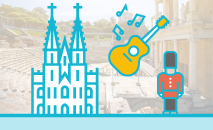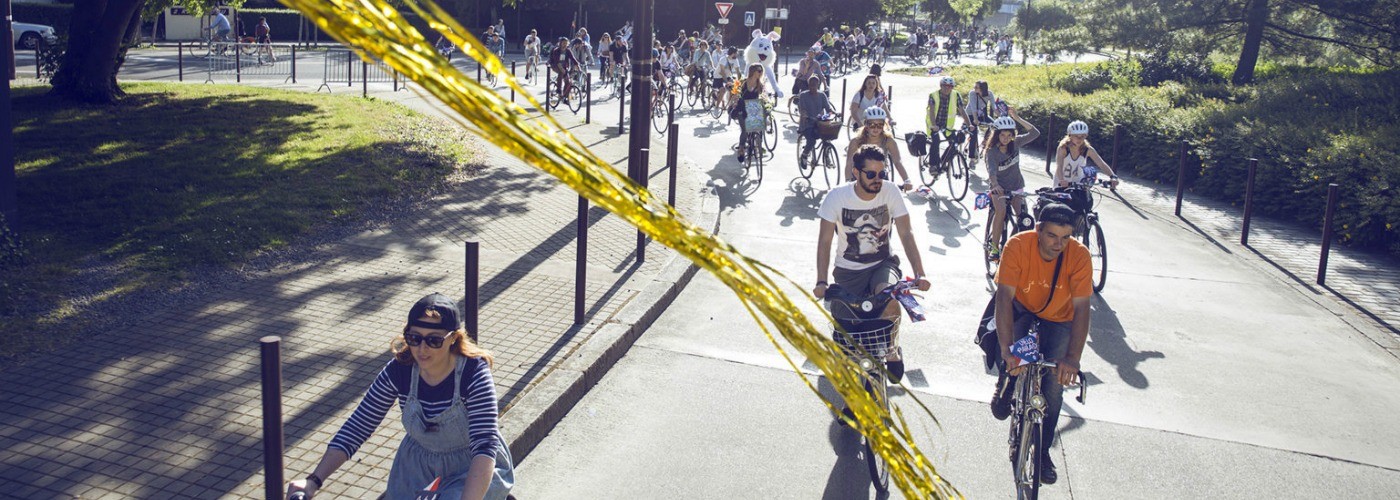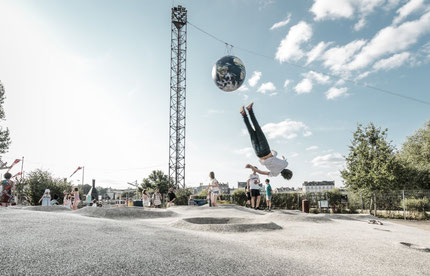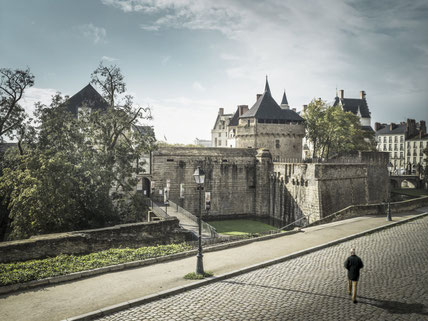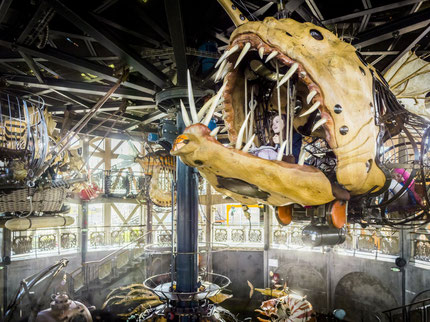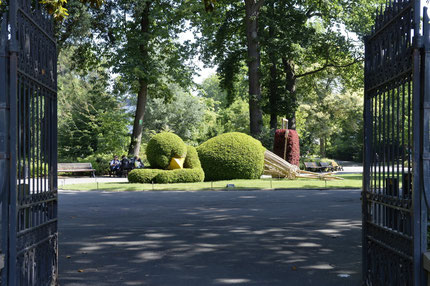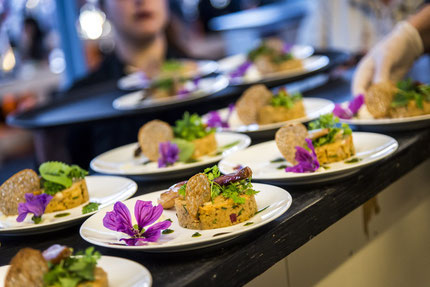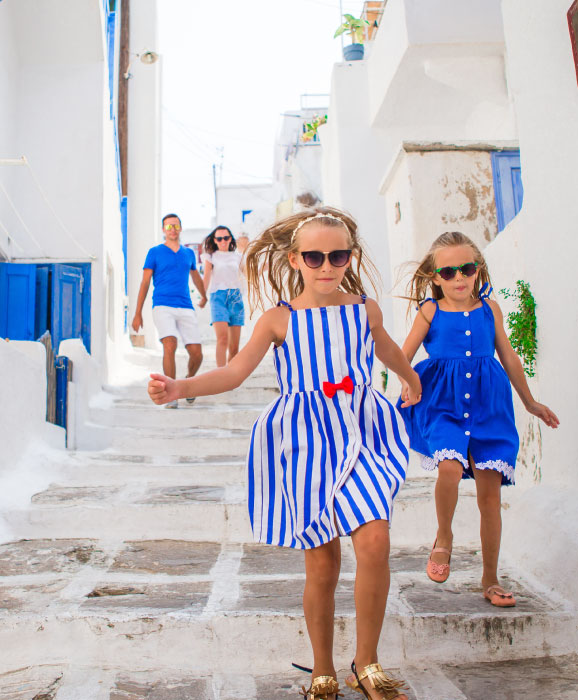
Nantes: visionary and creative
Once a busy seaport in the estuary of the Loire, the fascinating city of Nantes was chosen in the old times by the dukes of Brittany as their historical capital. If the city still boasts a unique architectural heritage with its magnificent Château des ducs de Bretagne, a Renaissance-style castle nestled in a fortress, a medieval quarter and one of the highest cathedrals of France - it has been transformed in the last 20 years probably more than any other city in France. It is not only a vibrant and young metropolis often rewarded for its top-quality of life - Nantes was also Green Capital of Europe in 2013 – but a city where art has literally been integrated in all possible aspects, making it a true example of how artists can turn a city upside down!
The Nantes-born writer Jules Verne would most likely not believe how creativity has made its way in Nantes: from narrow streets to boulevards, walk along the 15-kilometre long green trail, literally painted on the ground to enable visitors not to get lost, and you will be amazed by an incredible diversity of styles, atmospheres and artworks.
From 19th century Passage Pommeraye covered with an impressive glass-roof to the 20th design icon Station Prouvé; from the new Court House built by Jean Nouvel to the 18 gigantic rings of Daniel Buren (les anneaux!) displayed along the lively Quai des Antilles, on the banks of the Loire; and up to Le Nid, the panoramic terrace of the 32-floor high Tour de Bretagne, everything in Nantes is about transforming landscapes and visions into art. In which other city can you also ride a mechanical Elephant or a marine creature in a 35-metre high merry-go-round?
In the surroundings, discover the Estuaire Nantes–Saint-Nazaire art trail: also run by Le Voyage à Nantes, this unique collection of 30 artworks created by internationally renowned artists enables visitors to discover the diversity of landscapes along the Loire river’s estuary by boat, by car or bicycle.
Every summer the cultural project Le Voyage à Nantes invites artists from all over the world to use Nantes as a playground for their creativity.
Nantes is also tasty, with numerous markets offering a great diversity of local seafood, from langoustines to oysters, but also cheese, fresh vegetable, pastries and other delicacies. Many creative chefs have settled in Nantes and continuously reinvent the local cuisine. A few minutes outside the city, the vineyards are renowned for their refreshing, complex and expressive Muscadet wines.
Best hotel deals
in Nantes
Nantes
image gallery
Top things to do
in Nantes
Summer event Le Voyage à Nantes / in July and August
Every summer, Nantes gets a little more animated than usual. Le Voyage à Nantes does not only encourage art and culture in the city, but invites artists from all over the world to use Nantes as a playground for their creativity. Follow the green line and enjoy a 10 km long itinerary with surprising installations from artists, great exhibitions and playgrounds. Surprising, visionary, vibrant, innovative, creative... In one of its summer editions, The Sunday Times chose ‘loopiest’, much to delight of most Nantais! Something is sure: Nantes has become a phenomenon among all French cities. The next summer edition of Le Voyage à Nantes will take place from June 30th to August 26th 2018 – but the city can be visited any time during the year!
Château des ducs de Bretagne / Castle of the dukes of Brittany
The Château des ducs de Bretagne is a powerful symbol of Nantes' place in Breton history. The dukes having chosen Nantes for capital made the castle a real town within the town. The contrast between the exterior fortifications and the Renaissance-inspired inner buildings is unique. The castle was the last ducal residence of Brittany before the nation was merged with the Kingdom of France. It was also the birthplace and home of Anne of Brittany, who became twice Queen of France. Here in the heart of the city, you can retrace five centuries of history, admire the finely executed façades and loggias and walk the castle walls. Today the castle also houses the fascinating Nantes History Museum.
Les Machines de l’île
Les Machines de l’île is a unique attraction within the city's former shipyards on the Ile de Nantes (island of Nantes). The Machines, which now comprise a whole series of moving mechanical underwater creatures, insects and birds – as well as the iconic Grand Elephant – are the perfect illustration of the spirit of revival, audacity and creativity which drives Nantes. Crafted from wood, iron and leather, the Machines also help to preserve skills that were used in shipbuilding. Visit the Gallery of the Machines, have a go on the Marine Worlds Carousel and take a ride around the quayside on the back of the Grand Elephant. Jules Verne, who was native to Nantes, would have been delighted to see that his home town still invites people to dream and travel and loves a challenge, no matter how ambitious.
Fine Arts Museum of Nantes
Just reopened in 2017 and steered by the Stanton-Williams Agency (Royal National Theatre, Tower of London, Belgrade Theatre, etc…), the Musée d’arts houses a total of 17,000 m2, several exhibition halls and an auditorium. A key change is a 30% increase in exhibition space for one of the only ‘generalist’ museums in France. It is the only one outside of Paris able to present such an extensive and broad panorama of art stretching from the thirteenth to the twenty-first century. It has 10,000 works of art (paintings, sculptures, drawings, prints and contemporary installations), and several hundred masterpieces painted by Courbet, Picasso, Ingres, Chagall, de la Tour, Delacroix...
Jardin des Plantes – Botanical Garden
The Jardin des Plantes in Nantes was designed in the late 18th century. Today it is the fourth most important botanical garden in France for the quality of its collections; it houses 11,000 plant species and some 60 varieties of birds. The Jardin des Plantes also has one of the largest collections of camellias and magnolias in the world with 1,000 and 500 varieties of each, respectively. The botanical garden is just one of the city's many green spaces. In total, Nantes has over 100 parks and gardens, making it one of the greenest cities in Europe. It was even awarded the title of Green Capital of Europe in 2013.
Gastronomy - The best adresses
Nantes has a great positioning as regards food as the destination offers a great variety of fresh, healthy, locally produced vegetables and greens; the chefs do priviledge local, bio and short-circuit productions, which make our area the most important area of France in terms of bio products. The proximity of the ocean, plus the Loire makes is ideal to combine river/seafood products. The Nantes region has it own wine-growing terroir, the Muscadet, and not too far some world renowned productions such as sel de Guérande (salt).
The vineyards of Nantes and Clisson
Close to the Ocean, covering about 11,500 ha, the vineyard of Nantes is the cradle of the famous Muscadet wine and covers the largest wine producing area made from a single variety of grape anywhere in the world. The cellars are small, family run businesses; like the winemakers themselves, the wines are lively, cheerful and genuine.
A medieval crossroads on the Marches of Brittany, Clisson was developed by a number of artists and art lovers of the 19th century, becoming an idealised landscape inspired by Italy. The town has a unique character, both Breton and Italian, where tile and brick mingle with slate and granite. At the crossroads of three ancient provinces, Anjou, Poitou and Brittany, Clisson has a fascinating history that traces back to the 11th century. After the wars of Vendée in the 1790s, three characters with a love of Italy arrived in the area, the Cacault brothers and the sculptor F.F. Lemot. Together they introduced Italian architecture in the post war reconstruction of the valley. The Clisson castle, where the last duke of Brittany was born, stands on a rocky outcrop overlooking the whole town.
The art trail « Estuaire Nantes-Saint Nazaire »
The art project « Estuaire » is a collection of 30 contemporary artworks in Nantes and along the Loire. From April to October, you can take a boat trip down the Loire from Nantes to Saint Nazaire. The journey takes 2 hours 45 minutes and is a great way to discover the natural riverside environment as well as a number of artworks, including Tatzu Nishi's Villa-Cheminée and Jean-Luc Courcoult's Maison dans la Loire. When you arrive in Saint Nazaire, you should visit the impressive former submarine base where you will find Escal’Atlantic, a visitor experience relating the history of the cruise liners built in Saint Nazaire. You can then return to Nantes by train, a journey which takes 40 minutes.













